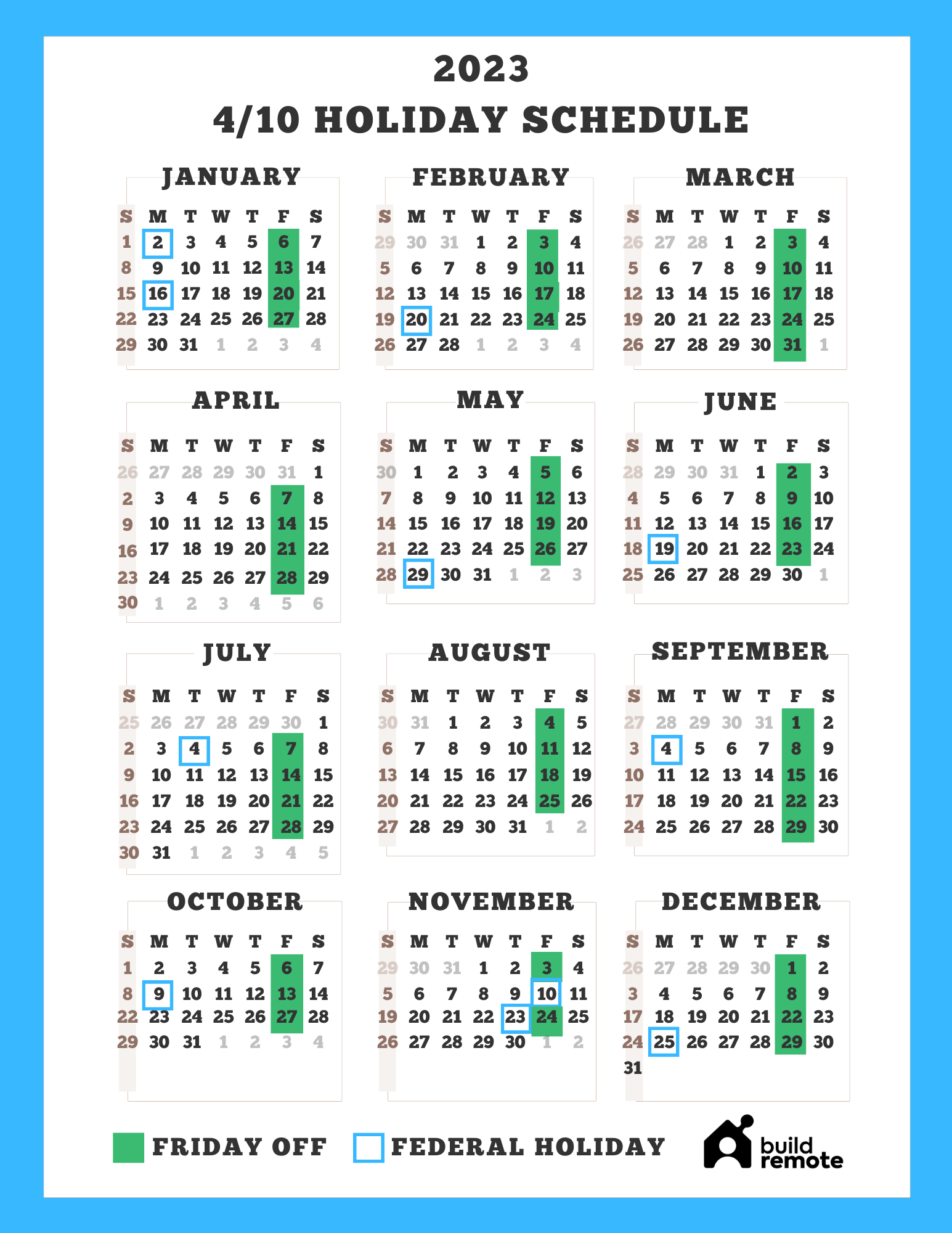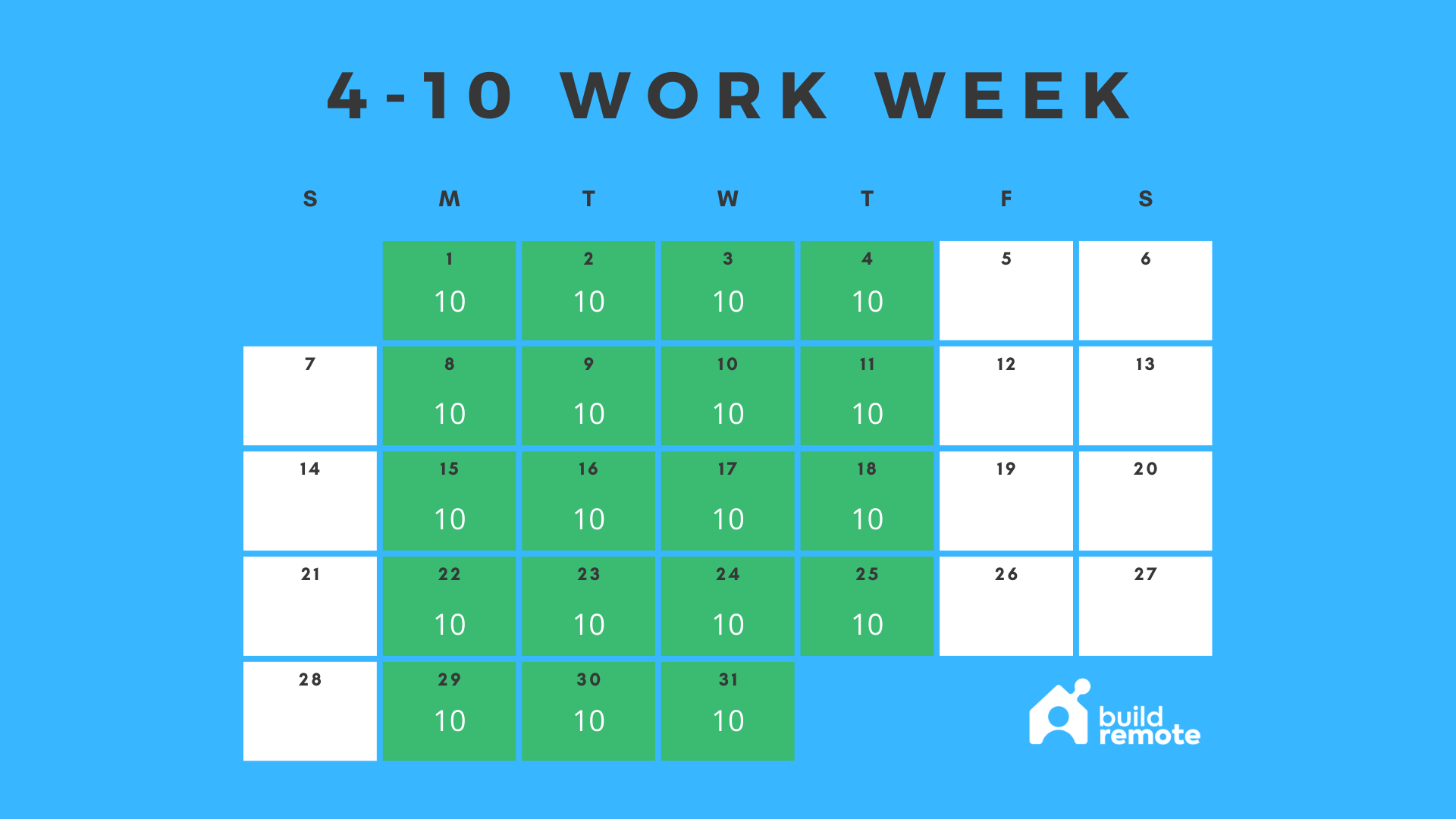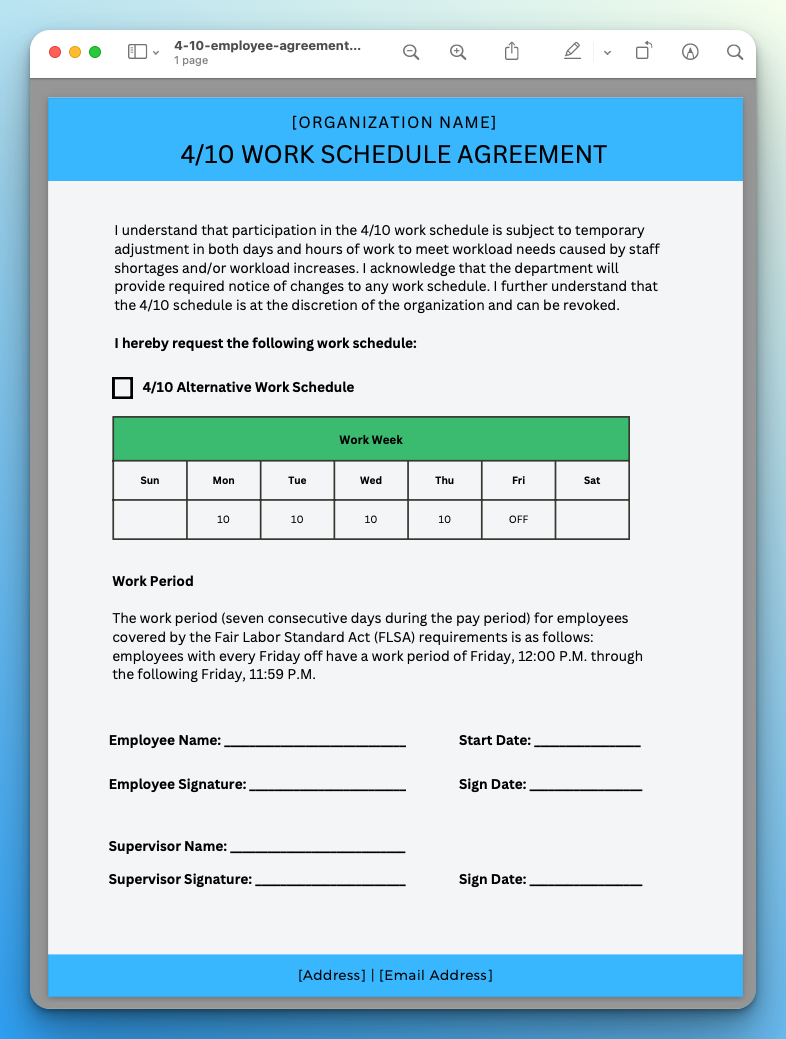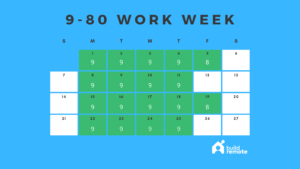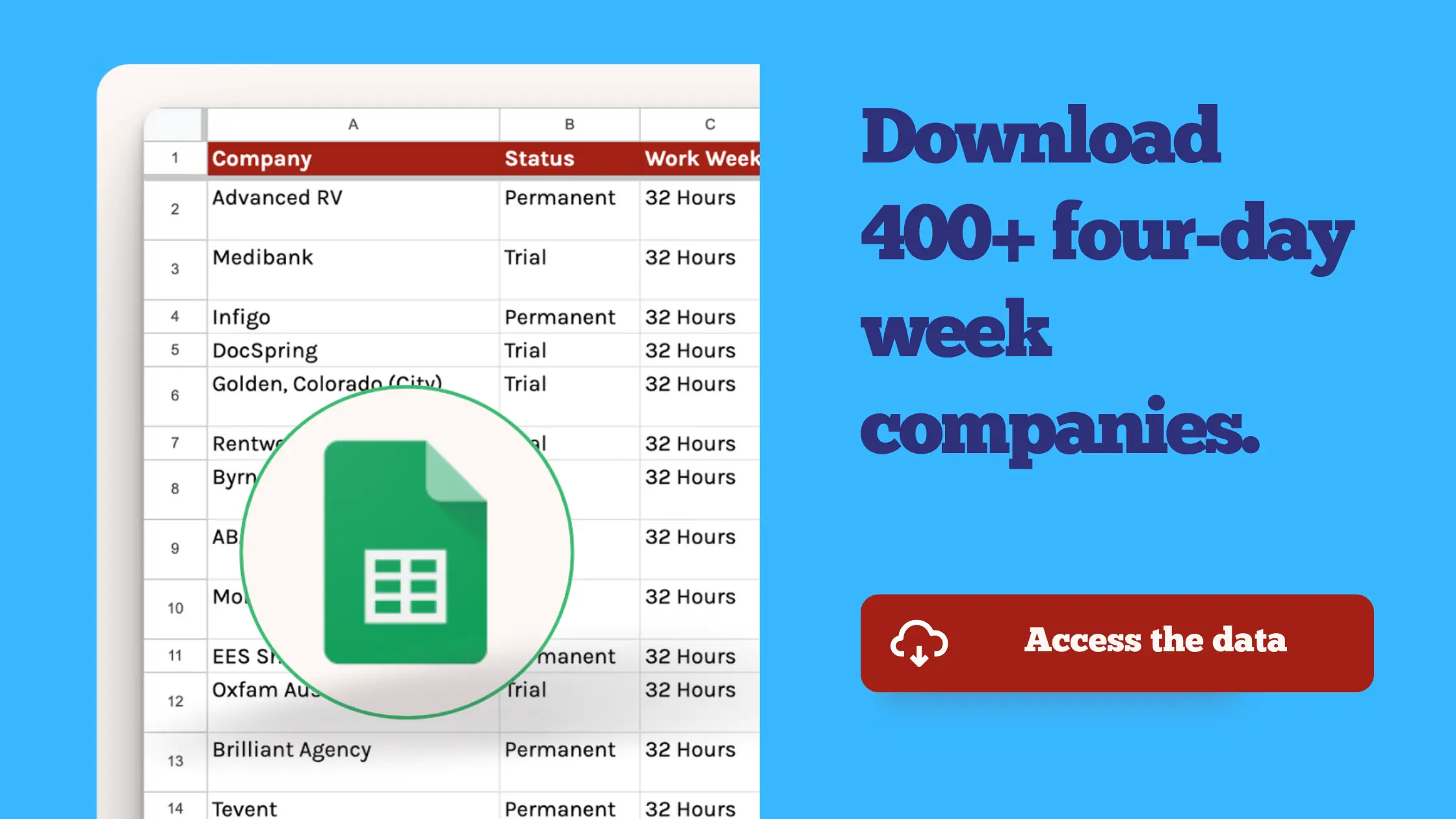4/10 Work Schedule: The Complete Guide [2024]
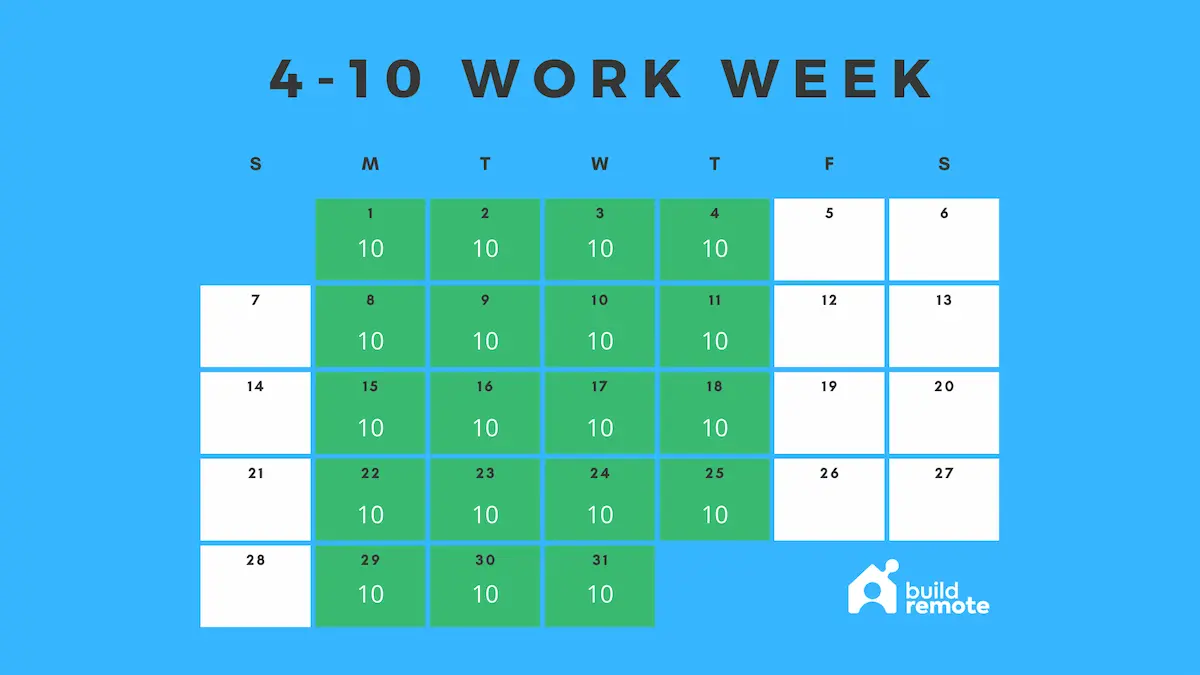
What is the 4/10 work schedule?
The 4/10 work schedule consists of four, ten-hour work days (typically Monday – Thursday) followed by a three-day weekend (typically Friday – Sunday).
Since you’re reading this article, I can assume you’ve made the giant step of questioning your standard work week. And it looks like you may want to learn more about the 4/10 work schedule. In this article, we break down everything you’ll need to know about and implement the 4/10 schedule.
Use the links below to jump to a section that interests you the most.
- 4/10 annual calendar template
- Schedule options & templates
- Employee agreement template
- Benefits
- Downsides
- Companies using the schedule
- How to implement
- Common questions
- > Where to find flex-schedule jobs
4/10 Annual Calendar Template
Here is a 2023 calendar for the 4/10 week. Fridays off are marked in green and US federal holidays marked in blue. These would be the typical days off for a company using this schedule.
Download the image | Use the template in Canva
4/10 Work Schedule Examples
There are a few different ways to manage the 4/10 schedule. You may have heard it called a compressed schedule, as well, since the schedule packs 40 hours of work into four days rather than five. The 4/10 schedule exchanges longer hours for fewer days. Here are the typical schedules that are used from most common to least.
See Also: The 10-Hour Shift Schedule: 4 Free Excel Templates
4/10 Compressed Work Schedule
This is the standard template that I defined above. Everyone works the same 10 hours for four days per week. The most common choice is to make Friday a non-working day.
Download the image | Use the template in Canva
Here’s what the 4/10 schedule looks like on a weekly basis:
- Monday: 8 AM – 6 PM
- Tuesday: 8 AM – 6 PM
- Wednesday: 8 AM – 6 PM
- Thursday: 8 AM – 6 PM
- Friday: Off
- Saturday: Off
- Sunday: Off
Flexible 4/10 Schedule Template
A flexible 4/10 schedule could mean a few different things depending on the company:
- Flexible days: Individual employees would work the 4/10 schedule but choose their day off (some would take Mondays, some Fridays, etc.)
- Flexible shifts: Every employee would work the 4/10 schedule but have flexibility to adjust their start and end times to whatever works best for them.
Learn more about flexible work schedules.
4/10 Shifts
Hospitals, manufacturers, and any organization with dedicated support (local governments, service providers, etc.) need to have at least some employees present during normal business hours. In that case, a company could choose to work the 4-10 schedule in shifts to ensure coverage on each weekday.
Here’s an example:
- Group 1: Monday – Thursday are work days, Friday is off
- Group: 2: Monday is off, Tuesday – Friday are work days
Fridays and Mondays are 50% staff, and Tuesdays – Thursdays are 100% staff.
See Also: The 10-Hour Shift Schedule: 4 Free Excel Templates
Seasonal 4/10 Schedule Template
This is the regular 4/10 schedule but used seasonally (usually in the summer). This could be offered as a benefit – “Fridays off in the summer.”
Similar Schedules
If you’re looking for other ideas, these alternative work schedules are similar, although not necessarily the same amount of hours. Here are a few of the most closely related ones:
- Four-day work week (or 32-hour work week): Four, eight hour days per week
- 9-80: Over a two-week period, people work the standard 80 hours but do it over nine working days rather than 10. This usually means every other Friday is off.
- 9/72: Eight-hour workdays with every other Friday off.
- Half-day Friday: Eight-hour workdays on Monday – Thursday, then four hours on Friday.
- 3-day work week
4/10 Schedule Agreement Template
If you’d like to offer your employees the option to work a 4/10 schedule, you may be looking for an agreement template to make your own. I’ve made a template that you can work with in Canva, Google Docs (or download to Microsoft Word), or a PDF. Use the links below to get the template.
Keep in mind: This template is not legal advice. Please advise your HR or legal team first to determine the right language for your 4/10 work agreement depending on your type of organization, employee status, state or country, etc.
Use the template in Canva | Use the template in Google Docs | Download a PDF
Benefits of 4/10 Work Schedule
A compressed schedule can be beneficial to the individual (employee or entrepreneur) and the company (the employer). We’ve organized these potential benefits into those categories.
For Individuals & Freelancers
- A shift in work-life balance: There aren’t additional hours available with this schedule, but there is an extra day cleared out. If you prefer to work longer hours, you’ll gain 52 extra days off per year.
- Personal time: I don’t work on Fridays. When other people are working or in school and you are off, you free up a new type of day for personal time: learning, reading, starting a side business, exercise, errands, etc.
- Potential lower cost for childcare: Having every other Friday off can remove the need for a nanny or day care that day. However, you’ll have to add extra hours during your workdays.
- Recovery time: Having a three-day weekend every other week helps get downtime away from work, which in turn, makes you more refreshed for work.
- Less commuting: For office-based companies, you’ll commute four days instead of five (saving 20% of your total commute time).
For Companies & Managers
- Attractive benefit for hiring: If a job candidate prefers longer hours in exchange for 52 additional days off per year, you’ve positioned your company well to hire that person versus a standard work week competitor.
- Better employee retention: Some employees may prefer a standard work week. But if you understand your team’s preferences and if most would prefer the 4-10 schedule, you’ve added a benefit that will help retain employees. Frankly, it’s hard to switch back to working five days per if you’ve gotten used to four.
- Same amount of hours: Companies can offer this benefit without decreasing work hours at all (if that’s necessary for the organization).
See Also: 22 Four-Day Work Week Benefits
Downsides of 4/10 work schedule
The four-day, 32 hour work week is, essentially, all benefit for the individual. You’ve removed standard work hours, added time off, and kept the pay the same as before. Who would argue against that?
But the 4/10 schedule is a tradeoff. For some, it may be worse to work longer hours for fewer days.
For Individuals & Freelancers
- Longer work days: Ten-hour days are 25% longer than what your team is used to. Employees may feel less productive (and less fulfilled) and they may have schedule conflicts arise.
- Less personal time on working days: On Mondays through Thursdays, you lose two extra hours of personal time. This could hurt your workout routine, family time, social engagements, and more. During the winter, you may be working through the entire light of the day. These are real potential downsides to longer working days.
- Childcare conflicts: What needs to happen with your childcare if you used to get home at 5:30 and now it’s 7:30?
For Companies & Managers
- Less coverage (for customer support): For organizations that need people available during business hours, you lose a day of support every week.
- Less productive hours: The two extra hours on workdays may be less productive than the hours you’ve traded out from Friday. When are you more productive, from 8-10 AM on Friday or 4-6 PM on Monday?
- Not for everyone: Some people may not like 10-hours days, which could remove some people from your talent pool (hiring) and current team (retention).
- Focus on hours instead of output: Although you’ve switched to an alternative schedule, you still haven’t questioned how time is tied to value or output. This schedule is still about counting hours instead of value provided. Although it may be an improvement, it’s not a cultural shift in how things are measured at the company.
Companies Using The 4/10 Work Schedule
We scoured the internet for companies that use the 4/10 work week so you could learn from the real policies in use. In the table below, you’ll see organizations that use this schedule.
Company | Policy | Jobs | Story |
Think Productive | Permanent | United Kingdom:
| |
City of Redding, CA | Optional 9-80 | January 8, 2018 | |
Lockheed Martin | Permanent | Unknown start date | |
Toshiba | Trial | Japan: | |
City Of Morgantown, WV (City) | Trial | For the next year a large majority of workers employed by the City of Morgantown will be working four days a week. 'Employees will work their 40 hours in four days or four 10-hour days,' she said." | |
Morrisons | Permanent | United Kingdom: The changes include a reduction of weekly hours from 40 to 37.5 – working nine instead of eight hours a day over four days, plus a six-hour day one Saturday per month." | |
Elephant Ventures | Permanent | United States: | |
Procurify | Optional | January 25, 2021 | |
Iloilo, Philippines (City) | Permanent | "We need to adjust because of rising costs of fuel. This will mean savings on electricity and less traffic. As an added value, this will also allow our officials and employees to have quality time with their families for three days — Friday, Saturday and Sunday," said Mayor Jerry Treñas. City Hall targets to open from 7 a.m. to 6 p.m., Monday to Thursday, to cover the required 40-hour work week. | |
Keller, Texas (City) | Trial | May 22, 2022 |
If you’re interested to learn more about the changing nature of work schedules, take a look at this list of four-day work week companies.
How To Implement 4/10 Schedule
Payroll
Normal pay weeks run from Sunday to Saturday (seven days). If you kept that format with a 4/10 schedule, you’ll still reach 40 hours within the standard pay week. Therefore, no overtime would be incurred.
Keep in mind: This template is not legal advice. Please advise your accounting or legal team first to determine the payroll setup for your 4/10 work agreement depending on your type of organization, employee status, state or country, etc.
Rollout
Like we recommended with the four-day work week, you can roll out the 4/10 in phases to reach the final, permanent policy. Here are some options:
- Seasonal: Implement a seasonal 4/10 schedule for the summer. For eight or 10 weeks, try out the policy with all employees. If it goes well, implement the new schedule permanently.
- Optional: Make this an optional program, not a requirement. Employees could choose to switch at any time.
- Flexible: Allow employees to choose their day off. If Monday works best for some and Friday for others, allow that choice.
Documentation
Depending on how your organization runs, you’ll most likely want to document which employees opted into the 4/10 schedule, when it started, and which days people work.
As I mentioned in the section earlier in this article, I’ve made a template that you can work with in Canva, Google Docs (or download to Microsoft Word), or a PDF. Use the links to access each template.
Keep in mind: This template is not legal advice. Please advise your HR or legal team first to determine the right language for your work agreement depending on your type of organization, employee status, state or country, etc.
Implementing The 4/10 Work Schedule In California
The 4/10 work schedule is an acceptable alternative work schedule in California if agreed upon by the employer and employee. California Labor Code 510 (section a) states “Any work in excess of eight hours in one workday and any work in excess of 40 hours in any one workweek… shall be compensated at the rate of no less than one and one-half times the regular rate of pay.” Unless “an alternative workweek schedule [is] adopted pursuant to Section 511.”
Please note: this is not legal advice. Please consult with your legal team before implementing the schedule.
4/10 Implementation Resources
Throughout the article, we shared a few templates for setting up a 4/10 work work. Here they are again so you can see them all in one place.
 |
4/10 holiday calendar for 2023 |
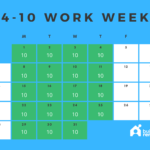 |
4/10 work week template |
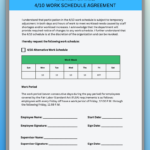 |
4/10 employee agreement template
(Use the template in Canva | Use the template in Google Docs | Download a PDF) |
Common Questions
I hope the sections above answered most of your questions. In my research, I found a few outstanding questions that needed to be answered. Please comment on this post below if you have questions I missed.
How is overtime handled on a 4/10 work schedule?
A company sets a standard work week for payroll. This is usually stated as Sunday through Saturday. Within that period, there are 40 work hours like a normal schedule. Anything on top of the 40 hours would be considered overtime.
Please consult your HR provider or attorney for guidance in your state or country, though. I’ve provided only general guidance.
See Also: Work Hours Calculator
How does a 4/10 schedule compare to a 5-8 (standard) work week?
Both schedules work 40 hours per week. A 4/10 compresses those hours into four workdays whereas a 5-8 is spread over five workdays. A 4/10 has longer hours with fewer days. Since it’s a personal preference as to which works better, you could offer the 4/10 schedule as optional at your company. That way, each individual has selected the best-fitting schedule.
What’s the difference between a 4/10 and 9/80?
Both schedules work 80 hours over two weeks (a standard template). The 4/10 schedule typically has every Friday off with 10-hour work days. In the 9-80 schedule, every other Friday is off.
Read more about the 9-80 schedule here.
View other unique work week schedulesThis is part of our series highlighting unique work schedules. Have a look:
|
Some of the links in this article are affiliate links that may provide Buildremote with a small commission at no cost to you.

